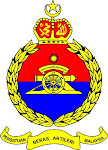A danger close OP bunker
How close are danger close missions? How close should they be? I recall the closest targets are about 800 metres for all shoots in Asahan Range. It is in the Range Standing Orders.
But what is the accepted danger distance to troops? I can only recall some principles in shooting danger close missions. Things like the range to the target; the 200 mils fan angle to the line of fire over own troops; calculations for splinter distance, which is 250 metres for the 105 shell and 400 metres for the 155 shell; the zone of the guns and the shape of the splinter zone. So much to consider. Corrections to adjustments were always calculated with the above principles factored in.
It was Ok when doing all the calculations during life firing training, but in war/ops? The over riding factors still remains in poor map reading and the actual locations of the gun positions, OP/FOO locations and the forward troops. The later Grid References amost imposible to verify.
I had my first real danger close mission during my Artillery Advance Course early 1970s, in the School of Artillery, Manly Australia.
Our practical OP training was at the Holsbury Artillery Range, north of Sydney. It was a two weeks life firing exercise, with every student conducting a danger close mission. We were to call for fire 50 metres infront of our OP position. Needless to say we were well protected as the bunker above. Shells would fall on top of the bunker during FFE. It may look safe but it sure was quite frightening with the blast and smoke coming into the observation slits. The shoot is quite tedious as only one student and an IG is alowed into the bunker for each mission. Just in case, it is for risk management if not anything else.
Calling danger close missions are compulsory in the wake of Australian Gunners’ experience in Vietnam circa 1960s as with the Battle of Long Tan. Fire support was called onto the ambushed troops position by the NZ FOO serving with the Australian Bty. It was deemed that it was better to bring fire onto one’s position as the final recourse, rather than be out numbered by the enemy during their assault.
My personal experience of a shell falling into my location was a single WP shell fired while doing adjustment in earnest and with great oversight (Nice way to say stupidity on my part) at the Inlet location in the Mong Gajah sector, Kedah. My FOO party was not protected with any OHP in our observation trench. I had conducted a danger close mission and I thought that I could “creep” well in my adjustment plan. The first round did not behave itself and fell into the camp, 50 metres from me. Luckily there were were no casualties. God was watching over me. He must have just smiled. God bless Him. I still shiver at the thought of the accident.
In hindsight, it was perhaps that I did not take into acount the slope effects; the wear and tear of the adjustment gun barrell, as guns with 50% worn EFC should not be used to fire danger close missions. It could also be the C of M as Mong Gajah is located in a hilly area and it was a cold morning. Yes the crest clearance at the target end was also definitely a major factor for which I did not take into account. I was over confident. After all I was trained in Australia, wasn’t I ?
For all it is worth, we will let the IGs have their say. Fortunately/Unfortunately there was no demand for a Board of Inquiry. It was deemed as part of our operational harzards.
I hope the new range at Gemas/ Asahan would have an OP bunker for danger close missions. I remember it was part of the Q brief when I was with the Gemas Project in the 1980s.
Allen Lai
Once a Gunner


















